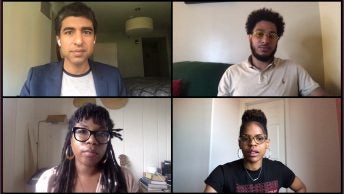Diamond Reynolds, Dr. Rhea Boyd, and Dr. Rachel Hardeman
Five summers ago, Diamond Reynolds was in the car with her partner Philando Castile as they drove home from the grocery store. Diamond’s four-year-old daughter was in the back seat.
In a matter of minutes, what began as a traffic stop for a broken tail light turned into a horrifying murder. While Phil was still seated behind the steering wheel, the police officer fired seven close range gunshots, five direct hits, two piercing Phil’s heart. Diamond can still smell the gunpowder. She can still see the blood.
No one except Diamond knows what it was like to be her that day or how they might have reacted in the moment. Diamond, through the shock, held up her phone and called the world into the car with her, livestreaming the aftermath on Facebook. Well before citizen videos of police brutality seemed commonplace, millions of people watched Phil’s final moments. Millions watched Diamond’s wrenching attempts to hold the police officer who killed Phil accountable.
While much of the world knows the events that unfolded that day, few have sought to understand the impact on Diamond during the long years since, what it has meant for her as a mother and as a human being who must carry on.
The first time I spoke with Diamond was last November. She was in her car and needed to leave soon to pick up her daughter from school. She felt raw. We spoke at intervals to hold space for her pain and also make time to breathe.
I asked two colleagues to join us who are experts on the impact of police brutality on public health–Dr. Rhea Boyd and Dr. Rachel Hardeman. With Dr. Boyd and Dr. Hardeman’s gentle encouragement, Diamond explained the ways stereotypes of Black mothers have compounded the trauma that she and her daughter have experienced in the years since Phil’s murder.
Diamond explained that because the police officer wasn’t held accountable for his wrongdoing, people seemed to need someone to blame. The livestream video she filmed generated an enormous public profile and all of the public projection that comes with it. Some misrepresented her intentions in speaking out against police brutality. Others sought to exploit her notoriety. Rather than being lifted up and supported, Diamond felt harshly judged everywhere she went. She felt scorned and she felt shunned.
The toll of these experiences was largely hidden from public view: the sleep loss, the anxiety, the disappointment, the anguish. Dr. Boyd and Dr. Hardeman explained that these symptoms of distress are common among those who bear witness to police violence. Diamond also helped us understand that the consequences are compounded by the scrutiny placed upon the witnesses, who are by and large Black mothers–the exhausting tropes and exalted expectations, the reduction in the public narrative of her entire life into that single moment.
The next time we spoke, Diamond continued reflecting on the insidiousness of racism. Dr. Boyd, and Dr Hardeman explained that repetitive exposure to racism, both direct and vicarious, can make the trauma inescapable. Just months before our conversation, another Black man named George Floyd was murdered by police in Diamond’s city. The video footage was everywhere. Diamond had become accustomed to avoiding news broadcasts but the exposures are not just on TV.
Black mothers like Diamond, face racism everywhere–even within the institutions whose purpose is to protect them. Amber Isaac, whose partner Bruce we spoke to a few months earlier, was repeatedly dismissed by providers, even as she developed a life threatening illness. Ultimately these dismissals proved deadly, an all too common pattern that partly accounts for why Black mothers are three to four times more likely to die in childbirth.
In reflecting upon a potential connection with my job as an obstetrician, I read a meme to the group that went viral this summer: “doctors are doing to Black women what police are doing to Black men.” Despite my inclination to draw a parallel, Dr. Boyd immediately corrected the false equivalence. The role of police in communities is different from that of doctors and the accountability of police is different too–in her view, there is much less of it. Police violence occurs with a higher degree of impunity. Dr. Hardeman agreed.
Equally pervasive across policing, medicine, and other institutions is the tendency to blame “bad apples” for racial violence and attempt to solve the problem by retraining or firing them. However the very fact that similar patterns exist in so many facets of American life underscores that the problem is structural and systemic. And therefore the solutions must be too.
Dr. Boyd described the opportunity to significantly increase the legal thresholds for initiating lethal force, and to standardize them. Broadening the call to reimagine our standards, Dr. Hardeman explained the need to make racial equity the mandatory minimum for our institutions rather than an aspirational goal to be addressed some day down the road. And Diamond called for basic accountability. When acts of deadly racism happen it is not enough to be outraged and then simply move on, nor is it reasonable to put the onus on Black mothers like her to speak out. Real change requires the sustained attention and effort of all of us.

– Neel Shah, MD
Credits:
Editorial consultant: Kimberly Seals Allers
Research assistant: Yara Altaher
Research manager: Jocie Fifield
Video editor: Mark Hoelscher



